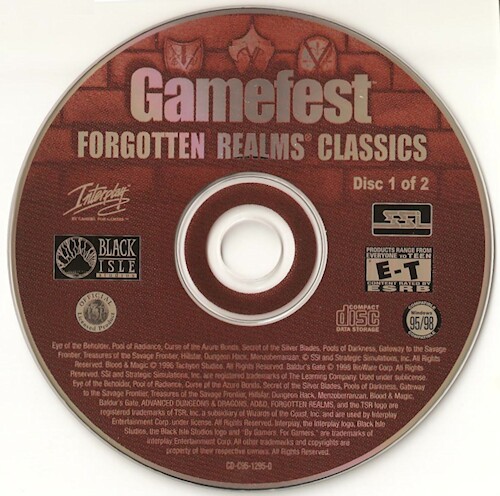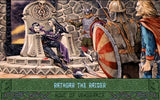
Actual Game
Forgotten Realms Classics
Pool of Radiance |
The Games
Though it has long passed into gaming legend the origin of the Gold Box series is worth repeating. In 1985 TSR, after seeing the success of the Ultima series, offered its license to game developers. The prize was awarded to SSI, primarily because of SSI's history of producing solid computer wargames. The first game released in the series was Pool of Radiance, in 1988. This was followed by Curse of the Azure Bonds, Secret of the Silver Blades, and Pools of Darkness. The games formed one continuous story rooted in the once-glorious city of Phlan and later encompassing the entire Moonsea Reaches and four outer planes. A series of TSR novels with identical titles paralleled the stories in the games, and also were best sellers. The original four titles were developed in-house at SSI, and were the best selling Gold Box games. Their success spurred an era of rapid growth at the company. I sometimes wonder what would have been the result had one of the other bidders, such as Electronic Arts or Sierra, won the license.
Though the early Gold Box games might seem primitive to a younger audience, in the late 80s they were like gifts from the gods. Rather than some type of mangled D&D system designed for mindless hack-'n-slash, players could create their own characters just the way they did in the paper and pencil game. All of the statistics were there, and they really seemed to have an impact on the game. Gamers playing as magic users had to relearn their spells every time they used them, just like in the game. All of the perennial favorites, like Fireball and Lightning Bolt and Magic Missile were available. Even better, the graphics were gorgeous for the time. In fact, many of the monsters' images were taken directly from the Monster Manual. The whole experience was like opening a Gygax book and being transported to the land. True role-playing!
What was remarkable was the sense of reality the games gave you. For the first time you weren't traveling through some random dungeon. The town of New Phlan, for example, felt like a real place, with a consistent street pattern that you would eventually learn. You weren't killing just to be killing; you had a purpose in mind and a goal to be reached. As your party went up in levels and could take on more powerful creatures, you also uncovered more of the story, working your way to a final confrontation with the Ultimate Bad Guy. True, it was the same "Kill Foozle" plot that's been used countless times before, but this time it felt fresh because you felt like you were actually living a D&D adventure.
As was possible when the various game series were released, characters can still be transferred from chapter to chapter. You can play the entire Beholder series, the Gold Box First Four, and the Savage chapters, all with the same parties.















